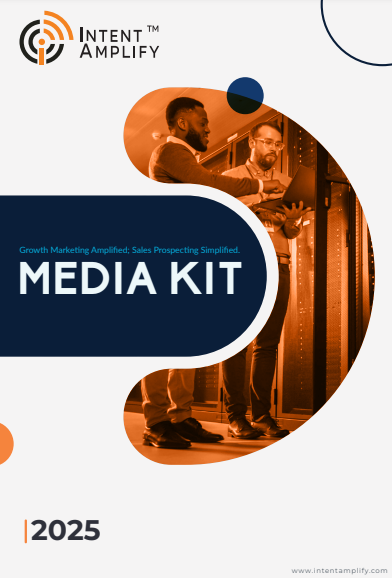
Stop Guessing B2B Marketing Campaigns: Build with Data, Not Assumptions
- Last updated on: July 18, 2025
B2B marketing campaigns are not a guesswork; stop doing it!
If that comes out as a strong statement, it is because it must be. In the hyper-competitive age, guesswork is a no-no. Guessing is a path to a blown budget, disillusioned buyers, and lost revenue goals.
You may have too many campaigns based on assumptions, such as what buyers may be interested in. What have been the buying trends in the quarter?, etc. But the reality is, B2B buyers aren’t buying on intuition.
They are buying based on research, signals, and intent. If your campaigns aren’t based on actual-time buyer behavior, you are just marketing blind.
The solution?
Do away with the antiquated personas and rigid funnels. Instead, make maximum use of intent data, behavioral signals, and actual buyer activity as the factors to design your campaign strategy.
It’s not a matter of doing more. It’s a matter of doing it smarter with accuracy, timing, and alignment that translates into real pipeline movement.
It’s time we called that out. In 2025, guessing is not a strategy. It’s a liability.
The Problem with Guesswork in B2B Campaigns
Despite good intentions, most B2B marketing teams continue to use antiquated processes based on assumptions rather than facts.
The catch is, guesswork isn’t always easy to spot. It’s hidden in the mundane: campaign planning, segmentation, content development, and performance reporting.
This contributes to a slow but eventual erosion of marketing effectiveness that damages strategic alignment and weakens pipeline impact.
What Guesswork Looks Like in Practice
It never quite heralds itself as a blunder. Rather, it appears like this:
- Defining audiences solely by job roles or industry segmentation.
- Triggering nurture streams with undefined buyer intent.
- Developing content on internal hypothesis, not actual cues.
- Success is measured through volume metrics such as MQLs and clicks rather than pipeline contribution.
Now apply that to a real-world situation:
A cybersecurity company unleashes a generic email campaign targeting all “CISOs,” only to find out that IT managers at mid-market companies are the real spenders.
A SaaS company builds top-funnel thought leadership while in-market buyers are hard-hunting for pricing decomposition and feature comparisons.
These are not simple, harmless mistakes. They hurt budgets, destroy engagement, and intensify the divide between sales and marketing. Worse, they produce internal frustration, particularly when the effort is great, but the outcome is uncertain.
Guesswork in B2B is not only unproductive, it’s out of touch with how 2025 buyers make a purchase.
Today’s B2B buyers don’t wait to be cultivated. They self-educate, compare solutions, and reach consensus internally, sometimes without ever completing a form.
So if your campaign plan is still based on personas developed a year ago and rigid deadlines on a marketing calendar, it’s not only misaligned, it’s out of sync.
What Today’s Buyers Are Doing
Today’s B2B buyers have purpose, speed, and autonomy. Here’s what it looks like in action:
Carrying Out Independent Research
Buyers spend more than 70% of their buying journey conducting research, never having a conversation with sales. They’re Googling, checking forums, reading blogs, and watching demos on their own schedule.
Relying on Peer Reviews Rather Than Vendor Statements
Review sites, social proof, and peer recommendations are more important than vendor-driven messaging. Buyers are valuing raw over refined.
Engaging in Cross-Functional Decision Making
Most transactions today have 6–10 influencers across various departments. Each has varied priorities, so the buying process is more convoluted—and more layered.
Leaving Behind Intent Signals
Each search inquiry, page view, asset download, and content share is a signal. They are digital breadcrumbs revealing what matters to buyers and when—if you’re listening.
Summary: Precision Wins in a Buyer-Led World
Today’s B2B buyer is deliberate, informed, and already moving. If your marketing isn’t built around their behavior, if it’s still driven by campaign timelines instead of buyer intent—you’re not just missing the pipeline. You’re losing trust, relevance, and momentum.
The buyer journey has evolved. Your campaigns should too.
From Insight to Action: How High‑Performing B2B Marketers Construct Intelligent Campaigns
When you know why buyers won’t wait—and how they act—the natural follow-up question is: What do high-performers really do?
Top B2B marketers in 2025 are doing these essential things:
Create a data-rich ICP, not a vague persona
They connect firmographics, technographics, deal history, and where prospects stand in the buyer journey so campaigns target accounts with the greatest likelihood of conversion.
Target accounts exhibiting in-market behavior
According to the Demand Gen report, 75% of purchasers now favor digital self-service and remote investigation. Marketers intervene when intent peaks—deep page visits or asset downloads tell them it’s time to step in.
Align campaigns to where purchasers are in their process
Mid-funnel assets, such as comparison guides are only delivered to accounts that exhibit evaluation behavior, rather than blasted to top-of-funnel audiences.
Personalize without Operational Complications
Many B2B teams are trying personalization today, but few are attempting it in a manner that’s scalable and strategic.
It begins with reading the correct signals, such as firmographics, buying stage, and intent data. Use that to inform your messaging in real time. The aim is accuracy, not overload.
It improves engagement when done right without leaving chaos behind the scenes.
Measure what moves the pipeline
They care most about campaign impact on qualified opportunities and closed revenue, not merely MQLs or clicks.
Why This Matters in 2025
Shoppers like digital self-service better than sales calls
Most B2B Buyers prefer self-searching. As per Gartner, an overwhelming 75% of B2B buyers now want a rep-free, digital-first buying process, keeping sales out until much further down the line.
Search is where it begins, and it’s deep
The average B2B buyer conducts around 12 online searches before even visiting a vendor’s site. Content influences decisions. According to Lead Forensics, around 90% of B2B buyers say online content plays a major role in their purchasing decisions.
Purchasing decisions are content-driven
Long-form articles, case studies, and reputable sources inform choices, making content a key driver of results.
From Guessing to Growth: Why This Moment Matters
When B2B marketers no longer guess and instead react to actual buyer behavior, everything changes.
Your campaigns no longer interrupt and instead integrate. You’re no longer firing wide messages with the hope that something will stick. Instead, you’re greeting buyers with the very insight they require, at the very moment they’re seeking it.
Guesswork undermines confidence among teams. Sales rejects marketing-generated leads, and marketing frantically tries to demonstrate ROI. But when campaigns are based on intent signals and buying-stage relevance, marketing has earned its place at the revenue table. Leads become legitimate opportunities. Pipelines become more predictable. And cross-functional alignment happens naturally.
This is no longer a “nice to have.” By 2025, it’s a competitive imperative. B2B marketing winners are those that swap assumptions for action, personas for behavior, and fixed calendars for dynamic, data-driven orchestration.
At Intent Amplify, we’ve assisted hundreds of B2B marketers in making this change. We don’t begin with content. We start with buyer behavior. Next, we construct omnichannel campaigns that align with real-world intent, not boardroom concepts.
Whether your pipeline is erratic, your CPL (Cost Per Lead) is inflated, or your team is fed up with guess-and-check marketing, it’s time to stop.
Final Thought: The Future of B2B Marketing is Predictive
B2B marketing has changed. B2B marketing campaigns have. Your buyers are now independent, research-focused, and impatient with indifferent messaging. They’re not waiting around to be courted; they’re researching, comparing, and shortlisting vendors while your team is still waiting for their phone to ring.
And still, most marketers are working with old-school campaign models, guessing whom to target, when to reach out, and what to say. That guessing results in inflated CPLs, lost revenue potential, and increasing tension between sales and marketing.
This piece examined why that model does not hold in 2025, and how top-performing marketers are replacing speculation with accuracy. From leveraging real-time intent signals and behavioral insights to redefining ICPs and constructing campaigns by buyer stage, the transformation is not one of adding complexity, it’s one of waste elimination.
We discussed:
- Why is depending on static personas and intuition-driven content at odds with how B2B buyers behave?
- How intent data, orchestration platforms, and CRM integration make for a real-time, always-on strategy.
- What leading marketers are doing differently: in-market account prioritization, personalization at scale, and measuring real pipeline impact, not vanity metrics.
- The risks of inaction: budget waste, disengaged prospects, and trust decay across go-to-market teams
It all comes down to the future being in the hands of B2B marketers who lead with intelligence. Campaigns that convert now are fueled by fact, not conjecture. When you cease to guess, you begin crafting campaigns that connect, compel, and drive outcomes throughout the funnel.
So, here are the takeaways
- Stop guessing.
- Start following actual buyer behavior.
- Start translating intent into impact with accuracy.
FAQs
1. How can Intent Amplify prevent my team from guessing?
Intent Amplify applies intent-based approaches to assist B2B marketers in finding active buyers, sending relevant content, and powering omnichannel campaigns aligned with true-world signals—not boardroom guesses.
2. How do high-performing marketers personalize without chaos?
They personalize using firmographics, technographics, and buying stage—via frameworks that facilitate scalable, dynamic content instead of producing boundless asset variations for each audience.
3. How does intent data enhance campaign performance?
Intent data identifies accounts that are currently studying subjects associated with your solution. With this, you can reach the right buyers, at the right moment, with the right message—influencing engagement and enhancing ROI.
4. How can I tell if my B2B campaigns are guesswork-based?
Red flags are having audiences defined in terms of job titles, touching off nurture streams without intent indicators, success measured through vanity metrics (such as MQLs), and delivering the same piece of content to all prospects, no matter where they are in the process.
5. Why does guesswork remain prevalent in B2B campaigns?
Most marketing teams are still operating with outdated methods, don’t have a single data platform, or are under pressure from within to be fast rather than plan. This results in campaigns that miss alignment with buyer behavior.



